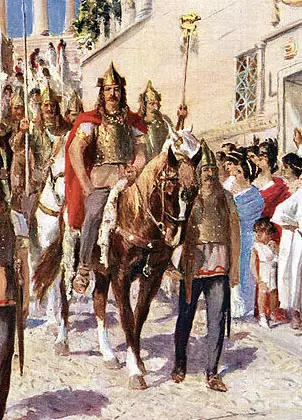Alaric The Visigoth
Alaric I was the king of Visigoths. Visigoths were the western tribes of Goths, the Germanic people who lived across Europe. Alaric is best known for the sack of Rome in 410, an event that eventually triggered fall of Roman Empire. Visigoths and Romans went to war against each other on numerous occasions. Alaric was the king of Visigoths from 395 to 410 AD till his death.


Early Life: Alaric was born in a noble Goth family of Peuce Island in modern day Romania. His family belonged to Tervingian branch of Goths. These people lived in Danubian plains. While he was a child, Alaric’s tribe had skirmishes with the Huns and was forced to migrate into Roman territory after setbacks against Huns. They also fought wars against Romans. Alaric started his military career as a member of Gothic leader Gaina’s army. In 390 AD, at a young age he joined Eastern Roman army.

Time in Roman Army: Alaric served in mixed band unit of Roman army in which Goths and allied people served. He quickly rose to prominence as an able military commander and went on to command this band. Alaric’s group was a part of the army that invaded Thrace in 391 AD. His army was subsequently stopped by Roman general Stilicho. Alaric led a 20,000 strong Goth army that defeated Arbogast, the Frankish general at the Battle of Frigidus in service of Eastern Roman Emperor Theodosius. He was instrumental in winning several important battles for the emperor.
His force alone lost 10,000 men in the Battle of Frigidus. However, Alaric felt that despite his services Emperor Theodosius did not recognize his services. Dejected, he left Roman army and was elected King of Visigoths in 395 AD. He marched towards Constantinople but was driven away by a strong Western Roman army. He subsequently marched into southern Greece. His army sacked Piraeus (port of Athens). They also pillaged cities of Corinth, Megara, Sparta and Argos. This made Theodosius’ successor, Arcadius appoint Alaric as Magister Militum (master of soldiers) of Illyricum.

Later Life: Alaric tried to invade Italy in 401 AD. His advances were repulsed by Roman general Stilicho. He again tried the same year but met the same fate. In 408 AD Western Roman Emperor Flavius Honorius, ordered mass executions of families of Gothic soldiers of the Roman military under the suspicion that they were conspiring to join hands with Alaric.
Thousands of women and children were killed by Roman population under instigation from Honorius. As a result, more than 30,000 Goths from Roman military defected and joined Alaric’s army.

Sack of Rome: After receiving support from the defecting Goths, Alaric started his march towards Rome in 408 AD. On his way he sacked cities of Cremona and Aquileia before laying siege to Rome. Roman senate moved quickly to grant him subsidy and his demand of freeing 40,000 Goth slaves was also met. However, Emperor Honorius refused to appoint him commander of Western Roman Army. As a result, Alaric again laid siege to Rome in 409 AD.
This siege also ended after he reached an agreement with Romans. However, the truce was short lived and Alaric besieged the city again for the final time in 410 AD. His allies inside the city opened the gates of the city for his army on August 24, 410 AD. Alaric’s forces sacked the city for three days. However, Goths were chivalrous with the inhabitants of the city and treated them kindly.

Death: After sacking Rome, Alaric and his army headed to North Africa. His fleet was destroyed in a storm however, and many of his men died. Shortly after, Alaric also fell ill and died in Cosenza, in modern day Southern Italy. The legend has it that he was buried under the riverbed of Busento River.




